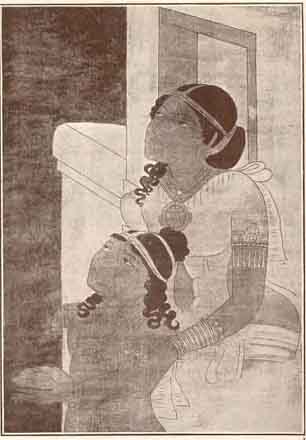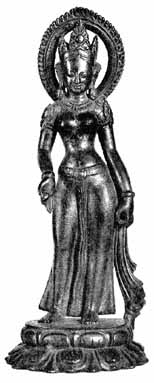
Selected Examples of
Indian Painting and Sculpture
BY O. C. GANGOLY
[In my Address before the Art Section of the Fifth Oriental Conference held at Lahore in November last, I tried to emphasize on the crying need, in our educational curriculum, for provisions and opportunities for students to develop their power of understanding and appreciation of the works of artists, ancient and modern, –to achieve a trained knowledge of the beauties of the Masterpieces of Art and of the principles upon which they are founded, –in the same way as elaborate courses are prescribed for helping students to form an intelligent acquaintance with the beauties of the Masterpieces of Literature, by an intimate study of the best examples of Poetry, Drama, and Prose (Belles Lettres) without any pretention to train up Poets, Dramatists, or Story-writers. Our modern education, while it has weaned and estranged us from the standards and ideals of old Indian cultural life and the forms and repositories of their expression, has created a gaping breach between our modern outlook and the forms of old Indian Art in which the best phases of Indian culture are incarnated. In this way, the gaze of the modern Indian has been gradually turned away from the visage of Indian Art. This has led to a lack of contact and sympathy. Indian Art has come to be regarded as something to be brushed aside, neglected, and ignored. In the field of Literature, a frequent contact with the Masterpieces of Letters, (be it in English or in the Indian vernaculars), has helped to awaken in our college students a reasonable critical sense for apprehending the values of literary forms of different periods and motifs and a fair amount of the power of appraisal of literary merits. In the field of plastic forms, the average educated man from college is utterly incapable of apprehending the merits of Visual Arts–of Painting, Sculpture and Architecture –not having an opportunity to train his vision or critical faculty of appraising the quality of beauty in a given work of Art, owing to a lack of contact with the Masterpieces of Art under any kind of trained guidance, –for, the Plastic Art is a forbidden fruit in our college studies. The doors of the Masterpieces of Buddhist Plastics, Brahminical Sculpture, or of the Schools of Rajput Painting, are as much barred against the comprehension of the average type of educated Indians as any European obsessed by Hellenistic or Greco-Roman prepossessions. But while the foreign critic, by reason of a general grounding in aesthetic education, is able to find a key to the understanding of Indian Art, to the educated youths from our colleges, the peculiar beauty and the special forms and motifs of Indian Painting and Sculpture appear to be for ever inaccessible. It is only by cultivating an intimate acquaintance and frequent contact with the different phases of Indian Art that Indians can be persuaded to realise the value of their priceless heritage. By the courtesy of the Editor of this Journal, it is my privilege to present in each number selected examples of Indian Painting and Sculpture, with suitable verbal comments, to accompany the reproductions. The Editor hopes by this means to awaken interest among educated Indians in the study and understanding of Indian Art, on which Indians have hitherto thought fit to heap nothing but disregard and neglect. It will be useful in this connection to recall the following remarks of Mr. E. B. Havell:
"Even if, for Europeans who think like Macaulay, all Indian Art should be worthless, it will always remain a priceless boon for Indians, offering them something which the best European Art can never give them. Let Indians of the present generation, who through Macaulay's narrow and short-sighted policy have never enjoyed this precious heritage, see that their children are put in possession of it."]
I
MOTHER AND CHILD
(Yasodhara and Rahula)
FRESCO CAVE XVII, AJANTA

MOTHER AND CHILD
Yasodharma and Rahula, Ajanta, Circa 500 A.D.
On the spacious walls of the cave temples and monasteries of Ajanta, the monk-artists of Buddhist India have bequeathed for us a rich series of fresco-paintings, which from the quality of their deep and sincere religiosity, their grandeur of design and rhythm, their free and sweeping brush lines, and, above all, their sublime vision, must be taken to rank with the best of the masterpieces of pictorial art in any part of the world. The finest achievement of Italian painting has become an indispensable part of the heritage of European culture. The mural paintings of Ajanta deserve a similar place in the renaissance of Asiatic culture. Da Vinci's Madonna of the Rocks, or Botticelli's Madonna of the Pomegranate is familiar to most schoolboys in England–but how many of our school-teachers or College Professors can claim familiarity with our Buddhist Madonna, one of the magnificent fragments of the mural paintings of Cave XVII at Ajanta? The priest-painters of these Buddhist frescoes attempt to transport us to a new world of spiritual dreams, realized in terms of a deep and intimate familiarity with the joys, the passions and the sorrows of human life, and set down in a language of Form in which the physical and the spiritual are fused in a happy harmony. This fragment of the representation of ‘A Mother and Child’ is said to illustrate an incident when the Buddha accidentally met his wife, Yasodhara, and his son, Rahula, as he went about begging from door to door in the city of Kapilavastu, which he had left as a Prince, and to which he had returned as a beggar-monk. The uplifted face of the mother of Rahula is illuminated with an expression of serene tenderness and a poignant pathos which easily rival many an Italian Madonna's. Her eyes, almost brimful with tears, plead as well as rebuke. They plead for the desolate heart of a deserted wife, and they rebuke the Prince for his begging bowl and his robe of renunciation. Yasodhara is pictured here as a veritable ‘Mater Dolorosa’ of Buddhist Art. Even if we eliminate the religious and the sentimental appeal in this pictorial composition, the remnant of its aesthetic and visual qualities offers a rich and perennial fountain of delight. The finely-poised head of the Mother, rich in its delicate and sensitive outlines, is echoed by the head of the child, placed at a similar angle, to lend emphasis to the design by a clever repetition. The gentle but sweeping curves and the nobility of the descending line of the arm and the hands, as they caressingly hold the child, almost merge in the outline of the figure of the child–thus blending the two figures in a happy unity. Indeed, all the motives and gestures of the two figures are attuned to one subtle and delicate harmony. The whole story is told through the medium of sensitive and sure outlines–without the aid of light and shade or modelling. In such supreme achievements of pictorial expression, the Indian artist anticipated the Italian painters by several centuries.
II
A BUDDHIST TARA
(Copper-gilt figure)
SCHOOL OF NEPAL, c. 12TH CENTURY

TARA
Nepalese School, Late 12th Century,
Collection of Mrs. A. DALY, DUBLIN
The development of Mahayana Buddhism has bequeathed to the Sculpture Gallery of Indian Art a shining gallery of images of great depth of conception, of sensitive forms, and of a wide variety of attitudes and gestures. In this example of a standing form of a Buddhist Tara (Saviouress), we have a conception of suave elegance, and at the same time an image of great power and concentration. The youthful body, posed in a sensitive avanga flexion, is graced by a soft and delicately contoured pair of arms–terminating in a pair of finely-modeled hands –(one in a abhaya mudra, and the other in a lola mudra) which are made to rest on the two hips–to emphasize, as it were, on the general effect of repose suggested by the figure. This static feeling is culminated in a head, conceived in an expression of deep and introspective concentration and meditation. As a saviouress burdened with the duty of relieving all the miseries of the world; her sense of responsibility is symbolised in a depth of expression–and a static self-contained movement. The facial expression is not the equivalent of an idle and passive reverie, but of an active sympathy with the sorrows of a suffering world, which the saviouress has accepted as her own, and of an energetic meditation for the means of alleviation. This deep and serious contemplativeness is relieved and illuminated by a sweet, but a very fragile smile, which seems almost to break under the burden of her sorrows, which are not of her own, but those of the suffering world. All the technical devices, and details of dress and iconography, are designed to emphasize on the sense of repose and contemplation. The whole pose of the figure affixed on the lotus pedestal, with the weight of the body laid on the left leg, is conceived in a delicate equilibrium. This sense of equilibrium is reinforced by the descending lines of the hands, and of the drapery, particularly of the uttariya, hanging in graceful and rhythmic folds from the left hand, its terminating end coming to rest on the pedestal. The only opposing movement is the upward spring of the three points of the tri-chuda crown, the effect of which is neutralized by the circular siras chakra, the decorative halo round the head. The lobes of the ear with their load of kundala are lengthened to touch the shoulders, the curves of which naturally lead to the bosses of the arm-lets on the upper arms, which slope down, in logical sequence, and melt into the descending lines of the hands- the sense of descent being carried and continued by the lines of the drapery until they reach the pedestal. In order not to disturb the effect of these descending lines, all the horizontal lines are given in soft and almost obliterated indications. The necklace (upagriva) and the waist-band (kati-bandha) are almost invisible, and their drapery across the breasts is barely indicated by a pair of soft lines. This skilful design of a cascade made of a series of sweet and
fluid lines, descending from the top to the bottom, is a happy and appropriate symbol of the flow of sympathy and mercy of the great saviouress,–the spiritual consort of Avalokiteswara-the Maha-karuna, the incarnation of Great Benevolence. Conceived with great power and concentration, this Indian statuette stands for an order of spiritual beauty which is on the opposite pole from the superficial flesh-forms of Greek Venuses, or Italian Angels.